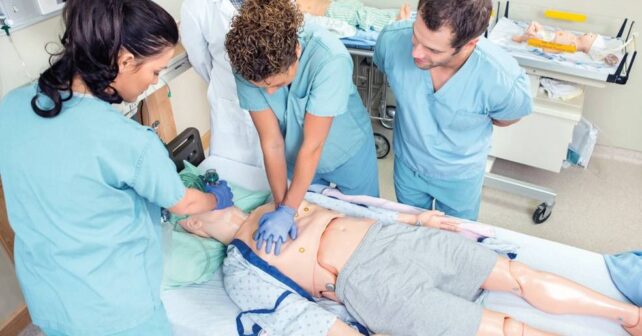
The landscape of medical education is evolving. Medical schools are transitioning from full days of lectures and printed copies of Harrison’s to the new age of small group, peer-directed learning with online texts and video/image-based learning. The same goes for residency training. One facet of this adaptation of our learning is the increasing use of simulation.
Explore This Issue
ACEP Now: Vol 41 – No 07 – July 2022Learning Through Simulation
From its early origins in 1968 with Harvey, a cardiology patient simulator presented by Dr. Michael Gordon from the University of Miami Medical School, the continued advances in technology have led to simulation training becoming a preferred method of learning. In various specialties of medicine, simulation has been shown to be equally, if not more effective, compared to live scenarios.1–3 Learning through simulation has many advantages including enhancing patient safety, exposing trainees to otherwise rare medical pathology, as well as the ability to manipulate multiple variables simultaneously thereby enhancing the complexity of cases with which trainees are presented.4 Most importantly, simulation provides unlimited opportunity for repetition and pattern recognition, a crucial element in emergency medicine training.
Outside of residency, simulation training has yet to gain a foothold. There is a belief that medical centers in large urban areas are the nucleus of the medical field, where the most cutting-edge medical care is being delivered. This often implies that rural hospitals or freestanding emergency departments are lagging in the quality or type of care they provide. While practicing physicians in urban environments likely get enough exposure to maintain their procedural and clinical skills, those practicing in rural environments may have less opportunity. On average, rural emergency departments, as compared to urban ones, have fewer overall patients per hour, leading to fewer critically ill patients, less exposure to rare pathology, and less trauma resuscitation.5 Rural emergency medicine might demonstrate the greatest benefit for routine simulation training. As an adjunct to daily practice, simulation allows physicians to keep their skills sharp and prepared for live scenarios. Beyond just the individual emergency physician, simulation can be used to sharpen the dynamics within the physician-led medical team. Running a medical resuscitation or multi-patient trauma are some of the highest stress environments a medical team will face.
Simulation as a Method of Improved Care
Through simulation and subsequent analysis/reflection, staff can identify areas to improve communication, efficiency, and confidence, thus leading to improved quality of care. While most simulation centers are in urban areas, the technological advances have allowed development of less sophisticated mobile simulation units. Such units have increased the extent to which simulation training can be utilized. Research from Canada showed the use of these mobile simulation units has been well received by emergency physicians.6 While this shows progress, opportunities for simulation in rural settings are fewer and farther between compared to those in urban institutions, emphasizing the lack of supply.6
Pages: 1 2 | Single Page




No Responses to “Simulating the Rural Emergency Medicine Physician”